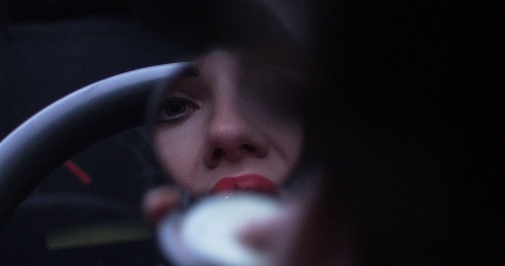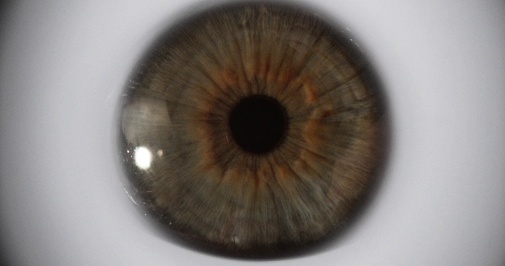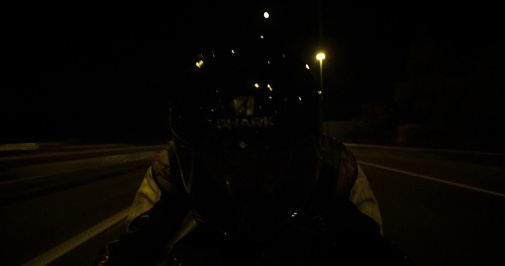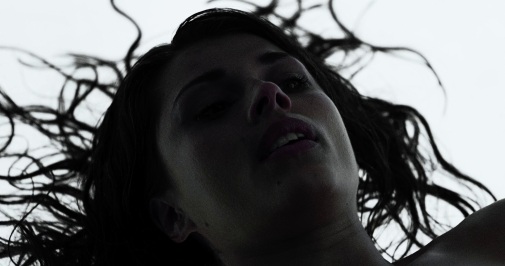Under the Skin @10: A Perfect Opening
 Thursday, April 4, 2024 at 9:00PM
Thursday, April 4, 2024 at 9:00PM 
Jonathan Glazer has scarcely left the news cycle since Oscar night. His speech against genocide caused much furor in Hollywood, where accusations of anti-semitism were promptly lobbied against the filmmaker. That said, today's topic isn't that media storm or the director's recent contributions to the Cinema for Gaza campaign. Instead, it's time to honor Glazer's third feature, which celebrates ten years since its US release. Loosely adapted from a Michel Farber novel, Under the Skin follows Scarlett Johansson as she roams the Scottish landscape in search of men. She's an alien creature whose conquests meet a nightmarish demise, and her film is one of last decade's most tremendous cinematic achievements.
I'd go so far as saying that any "best of the 2010s" list that doesn't include it is highly suspect. Indeed, Under the Skin secured its masterpiece status rather instantly in my eyes, its opening like the protagonist's seduction – impossible to resist even as it plunges you into oblivion…

That experience is still sharp in my memory. It was May 2014, and my second year of college was coming to an end. Back then, I used to take advantage of free Thursday afternoons to catch the latest releases, though the school often programmed seminars with theater professionals for those hours. Maybe I should have attended more of those, but film was a siren call too tempting to resist. And so, my favorite place to spend those hours between classes and the evening commute back home was a small arthouse-type cinema that tended to be empty during weekdays, apart from a few pensioners who'd spend the day dozing in and out of consciousness under the theater's AC.
Looking back, Under the Skin was the kind of title I often watched there, but I'd read some thrilling things about the picture's formal elements and wanted to witness them in the best conditions possible. Sadly, that made the little cinema a no-go. Its screens were on the smaller side, with one of the four rooms suffering from a subpar sound system to boot – two years later, American Honey crackled like an avant-garde experiment. So, instead, I ventured into one of the bigger theaters at some posh mall a subway station away, where things were bound to be busier, but at least I'd get a better grasp of the movie's merits.
Because Scarlett Johansson was the star and The Avengers had just rocked the box office a couple of years prior, Under the Skin got one of the place's bigger screens, blockbuster-style – can you imagine Glazer making one of those? However, that was the second week in its theatrical run, which meant word of mouth must had already made casual moviegoers aware of the film's true nature. Long story short, only I and one other guy were present for that screening. We often talk about the buzz of watching something in a crowded room, but an empty cinema can be just as pleasing. Sometimes, when it's (almost) just you and the screen, one finds the perfect staging for a silent dialogue, a communion, or, in this case, a trance.
Right off the bat, the credits suck you into the void, unnervingly silent and straightforward, no music to lull you into comfort. When Mica Levi's score manifests, it's not beautiful or even melodic, rather an ambience of disordered noise that simultaneously suggests a mechanism and an organic something. Could it be an animal's guttural insides? And what about that light that bursts through the dark? In the cinema, it felt like a second projector had lit up, facing the audience as if we two were the spectacle for some unseen viewer on the other side. The score gets louder, its cycle quicker, bubbles floating up in stomach acid. A change in perspective introduces circles into the image, either a trick of the flash or volumes in space.

Are these planets against a sun? An eclipse? The mind reaches for meaning in the nothing, but Under the Skin keeps its secrets close to the chest. Just as one starts to doubt that these are planetoid spheres, a voice gurgles into the cacophony, androgynously husky, monstrous in its sonic styling. It sounds a bit like the stutter or a word trapped in the throat, trying clawing its way out. The frame, too, seems to be inching out of the penumbra, blackness reduced to a circle in pools of gray and white. Slowly, it's difficult to accept the shapes as anything but an eye. It is not yet complete but sketching itself into existence. An iris contracts, the mumbling gains the shape of language, and, from the dark, the eye is born. It looks straight ahead. It looks at you.

Startling and confrontational, these images give way to a title card and then to murky vistas of a place we'll eventually identify as Scotland. It's too dark to discern much past lines and glimmers, a motorcycle coming into view across a tunnel and lonely road. Glazer and cinematographer Daniel Landin capture the reflections on the driver's helmet with depersonalized detachment, rendering it little more than a machine. At best, it's an insectoid eye, so very different from the eclipse turned human oculus. What's familiar is now alien, and even a straightforward motion carries new enigmas.

On the side of the road, the bike stops, its driver goes into the shadow and comes back carrying an unconscious woman. There's no expression, no discerning emotion or hesitance. This is routine, a clockwork ticking away as it has done countless times before. In the meantime, Levi's score has become more music-like, introducing strings sibilant, the wind's whisper or perchance a mechanical hiss. Before it can resolve into a shape more understandable to the ear, it stops altogether—the image cuts in solidarity. Silence is absolute and we get our first close-up of a human face, that of the woman picked up by the wandering rider. She's dead, eyes staring unmoving. Staring at nothing.

Against blinding light, her hair forms a pool of black. In a more poetic setting, it might inspire someone to think of Medusa, but here, it just completes the picture of human roadkill. Someone's moving her, rustling through her clothes, taking them off without reverence for the dead. She's an object now. But where are we? The lighting occludes dimension, so we only see bodies and our trusty companion – the void. It's white now. Later, it'll be black when welcoming men to their end. Though death is also present here, the scene is a birth. Not of the body undressed, of course. It's the body pilfering her clothes, becoming a person as putting on a costume.
For all the nudity and shots of stockings sheathing over smooth skin, there's nothing erotic here. Tensions of desire will repeat throughout the film, but recognizable eros rarely presents itself. If it did, the barebone soundscape would dilute it, and so would the editing. Glazer and Paul Watts cut like clockwork – there's that word again. The motion of succeeding shots must be maintained, the rhythm divorced from the actor's gesture or whatever narrative momentum one can surmise from the material. Any emotional intuition is similarly thrown to the wayside in favor of a cold clinical metronome. It's inhuman, like glimpsing into what our physical selves might look like seen through a gaze so distant it transcends any form of reality we could accept as our own. But wait, something curious happens.

The thief, that alien someone, stops on its track. Neither Scarlett Johansson nor the image gives away the motivation behind the pause, but in visceral terms, it feels like curiosity. A hand reaches down, catching something left behind on the corpse. It's tiny, a bug that, in backlighting, converges with the humanoid appendage where it stands, fused in shadow. Its movement is too frantic, though, too familiarly animal for earthly eyes. It's nothing special. For the alien, however, it's as mysterious as Under the Skin has been to the viewer. Suddenly, we seem to enter the stranger's subjectivity, an extreme close-up of microscopic proximity that, nevertheless, could be a POV shot. Is the figure becoming more human, or are we becoming more alien? Both?

We'll never see this white-out dimension again in Under the Skin. It'll be left behind as Johansson and Glazer's camera move into real locations, banalities turned strange and cosmically foreign. Again, it's the subjectivity of an observer for which commonplace sights are case studies into a mysterious other. We might feel the same when looking at an ant colony, for example. Sensing it when looking at people – or figures that ostensibly appear to be people – is, thus, another of the director's disquieting notions. Glazer gets at de-humanization, perfected through film's formal architecture, and challenged by a non-story that asks the viewer, time and time again, what it even is to be human in the first place.
Empathy seems the answer at the end of the film, to recognize yourseld in the other and others in yourself. Yet, physical or mental, spiritual or instinctual, what makes us human remains a truth that should be simple, but isn't. It never was.
Re-watching Under the Skin, I'm transported back to that afternoon, almost a decade away. I can taste the old euphoria in the back of my throat and taste it again, as fresh as ever. Though I might appreciate The Zone of Interest or swear undying love to Birth's vivisected melodrama, I doubt Glazer will ever make another film that means more to me than this extra-terrestrial picaresque. And, while his write-up is dedicated to the picture's initial ten minutes, any given scene is as prone to deep analysis or besotted reminiscence. Think of the deaths in nothingness, the baby alone on the beach, a body popping like a balloon, a face discarded and re-considered, smoke in the snow – what a picture!

Under the Skin is currently streaming on Kanopy and Max. You can also rent and purchase it on Apple TV+, Amazon, Google Play, YouTube, Flix Fling, VUDU, and the Microsoft Store.



Reader Comments (1)
I saw this at the now-defunct Lefont Sandy Springs which was the nearest art-house theater 15-20 minutes from where I live (if you don't use the freeway) as it was unlike anything I have seen as I saw this with Joe as part of a double-feature of sorts. It is truly one of the finest films of the 2010s as it didn't just confirm what I already knew about Jonathan Glazer as a filmmaker but it reminded me into why I loved Scarlett Johansson back in the early 2000s as it would lead to this career renaissance of sorts for her having been through some terrible mainstream films in the late 2000s (not counting the stuff she did with Woody Allen) as she would create this nice balance of films for the MCU, arthouse, and mainstream as it took her a while to do all of that and so much more.